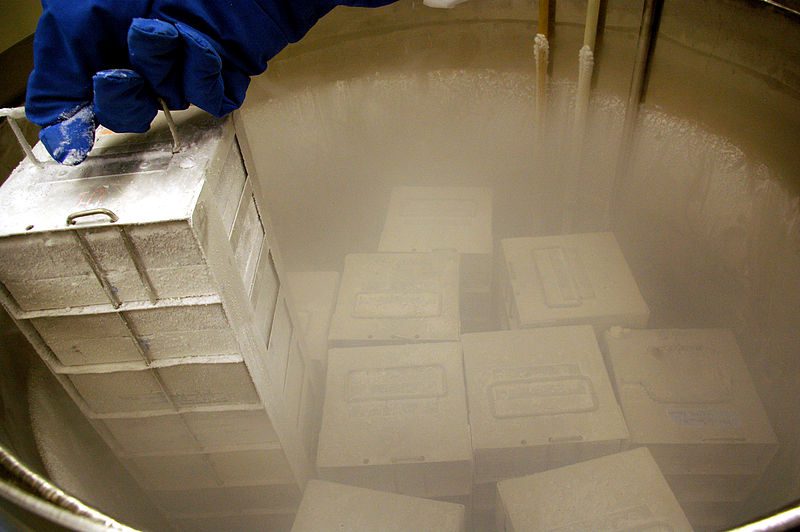A newly introduced technique takes bioprinting -; where the ink of cells does printing, layer by layer, forming a structure -; to a whole new and icy level. “Cryobioprinting” is a process that employs bioink embedded in cells to print intricate frozen structures that may be readily stored for later use, according to researchers at Brigham and Women’s Hospital’s Zhang lab.
In a recent publication published in Matter, the researchers presented cryobioprinting, and in an article just published in Advanced Materials, they describe how to use the approach to construct muscle tissue in greater detail.
“Cryobioprinting can give bioprinted tissue an extended shelf life. We showed up to three months of storage, but it could be much longer. And the unique variation, or what we call the vertical 3D cryobioprinting technique we’ve described, may have broad application in tissue engineering, regenerative medicine, drug discovery and personalized therapeutics.”
Y. Shrike Zhang, PhD, Study Senior Author and Associate Bioengineer in the Department of Medicine, Brigham and Women’s Hospital
Zhang and his colleagues printed tissue structures on a customized freezer plate using cell-laden cryoprotected bio-ink. With the help of the freezer plate, the researchers could precisely regulate and stabilize the temperature during the cryobiotic procedure. The printed structures were instantly cryopreserved in a liquid nitrogen tank for future use. The researchers improved and tested the approach and discovered that it could accurately generate tissue constructions that may be utilized as implants and tissue products.
In their article in Advanced Materials, Zhang and his co-authors describe how they used cryoprotected bio-ink to produce vertical 3D structures that resemble the complex, fragile, and anisotropic tissues seen in the human body. Many tissues, such as muscles and neurons, are anisotropic, meaning they have distinct characteristics in different directions. The researchers’ created structures were also anisotropic, with microscopic pores arranged vertically.
The scientists created a muscle-tendon unit using myoblasts (cells that may give birth to muscle cells) and fibroblasts (cells that produce structural frames in connective tissue) to prove the concept. The researchers also created a muscle-microvascular unit.
The researchers point out that this is still an early technological demonstration and that considerable validation and testing will be required before clinical usage, but both studies are significant steps ahead.
According to Zhang, “As the field of tissue engineering grows rapidly, these fabricated tissue constructs can find a plethora of applications in muscle tissue engineering and beyond.”
Story Source:
Ravanbakhsh, H., Luo, Z., Zhang, X., Maharjan, S., Mirkarimi, H. S., Tang, G., … & Zhang, Y. S. (2021). Freeform cell-laden cryobioprinting for shelf-ready tissue fabrication and storage. Matter. doi.org/10.1016/j.matt.2021.11.020.
Luo, Z., Tang, G., Ravanbakhsh, H., Li, W., Wang, M., Kuang, X., … & Zhang, Y. S. (2021). Support Bath‐Free Vertical Extrusion Cryo (bio) printing for Anisotropic Tissue Manufacturing. Advanced Materials, 2108931. DOI: 10.1002 / adma.202108931
Learn More:
Top Bioinformatics Books ↗
Learn more to get deeper insights into the field of bioinformatics.
Top Free Online Bioinformatics Courses ↗
Freely available courses to learn each and every aspect of bioinformatics.
Latest Bioinformatics Breakthroughs ↗
Stay updated with the latest discoveries in the field of bioinformatics.
Dr. Tamanna Anwar is a Scientist and Co-founder of the Centre of Bioinformatics Research and Technology (CBIRT). She is a passionate bioinformatics scientist and a visionary entrepreneur. Dr. Tamanna has worked as a Young Scientist at Jawaharlal Nehru University, New Delhi. She has also worked as a Postdoctoral Fellow at the University of Saskatchewan, Canada. She has several scientific research publications in high-impact research journals. Her latest endeavor is the development of a platform that acts as a one-stop solution for all bioinformatics related information as well as developing a bioinformatics news portal to report cutting-edge bioinformatics breakthroughs.






